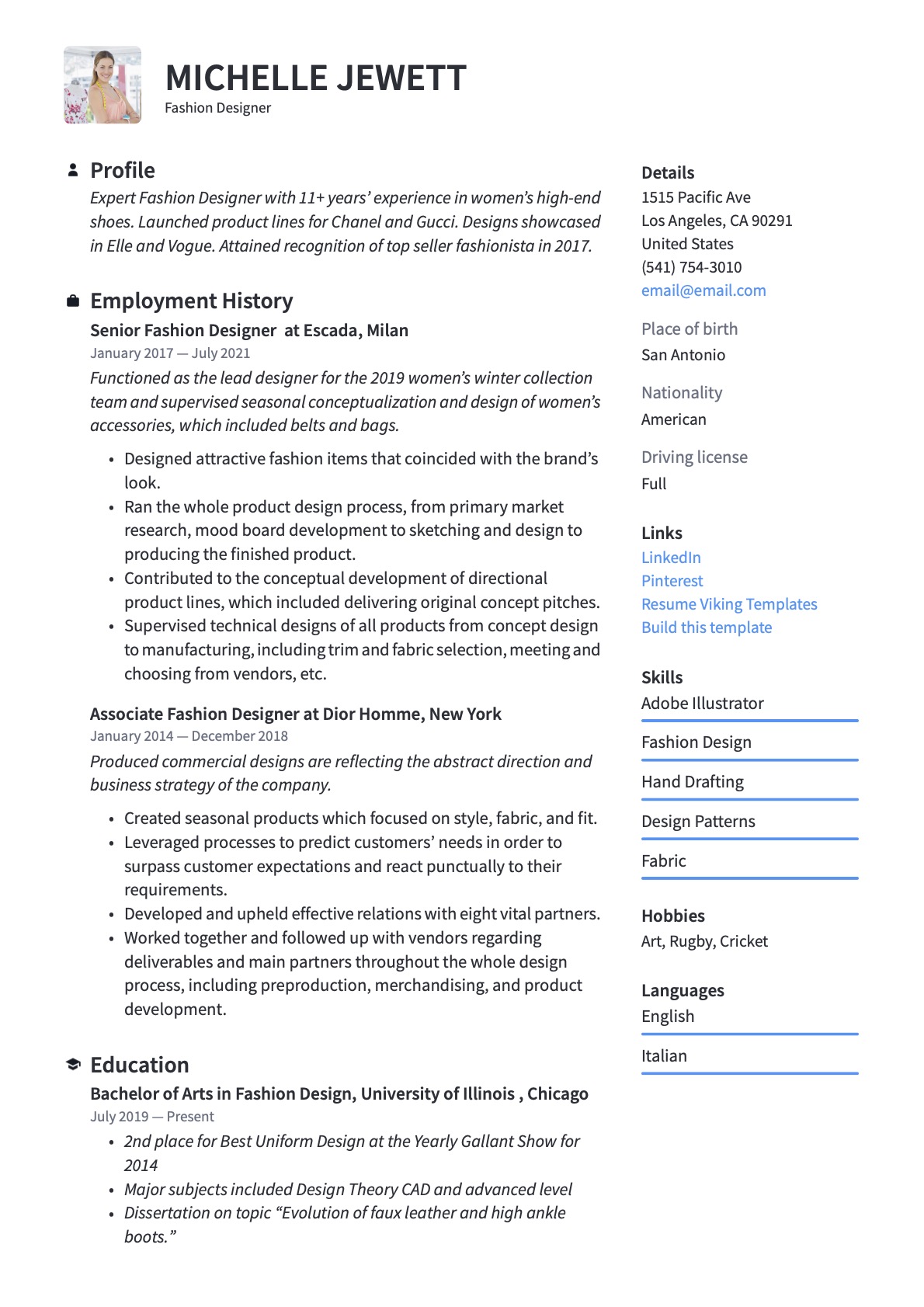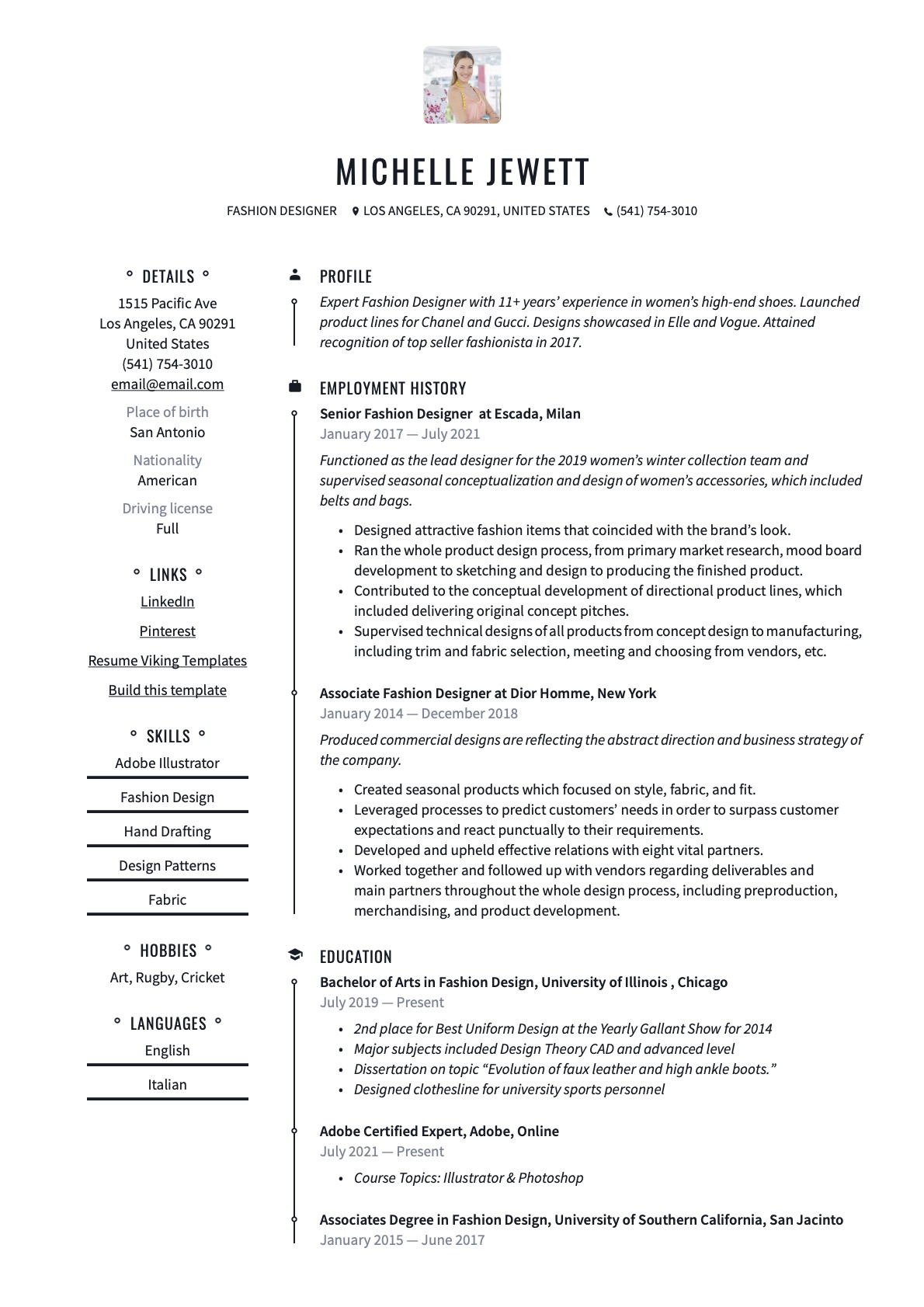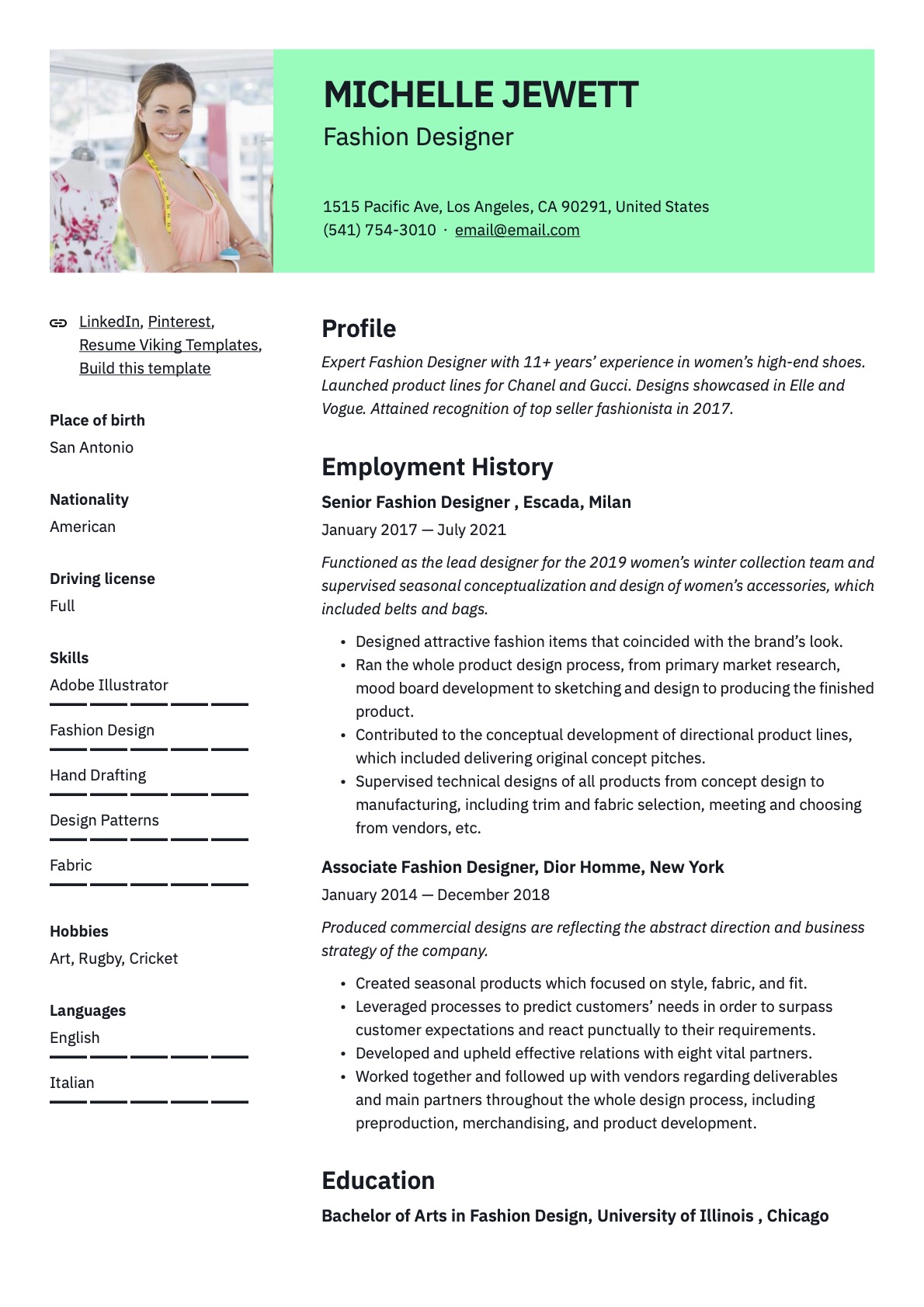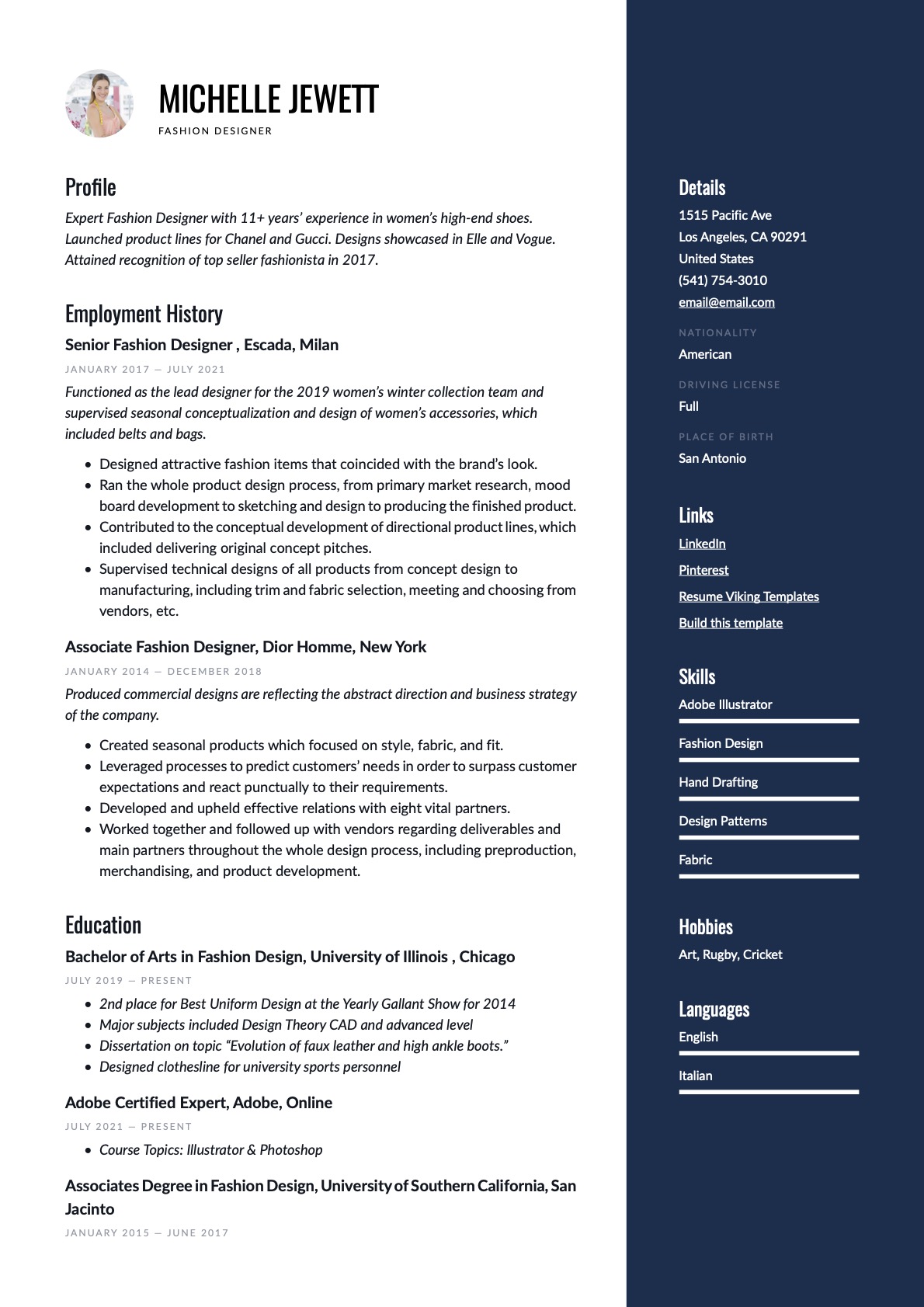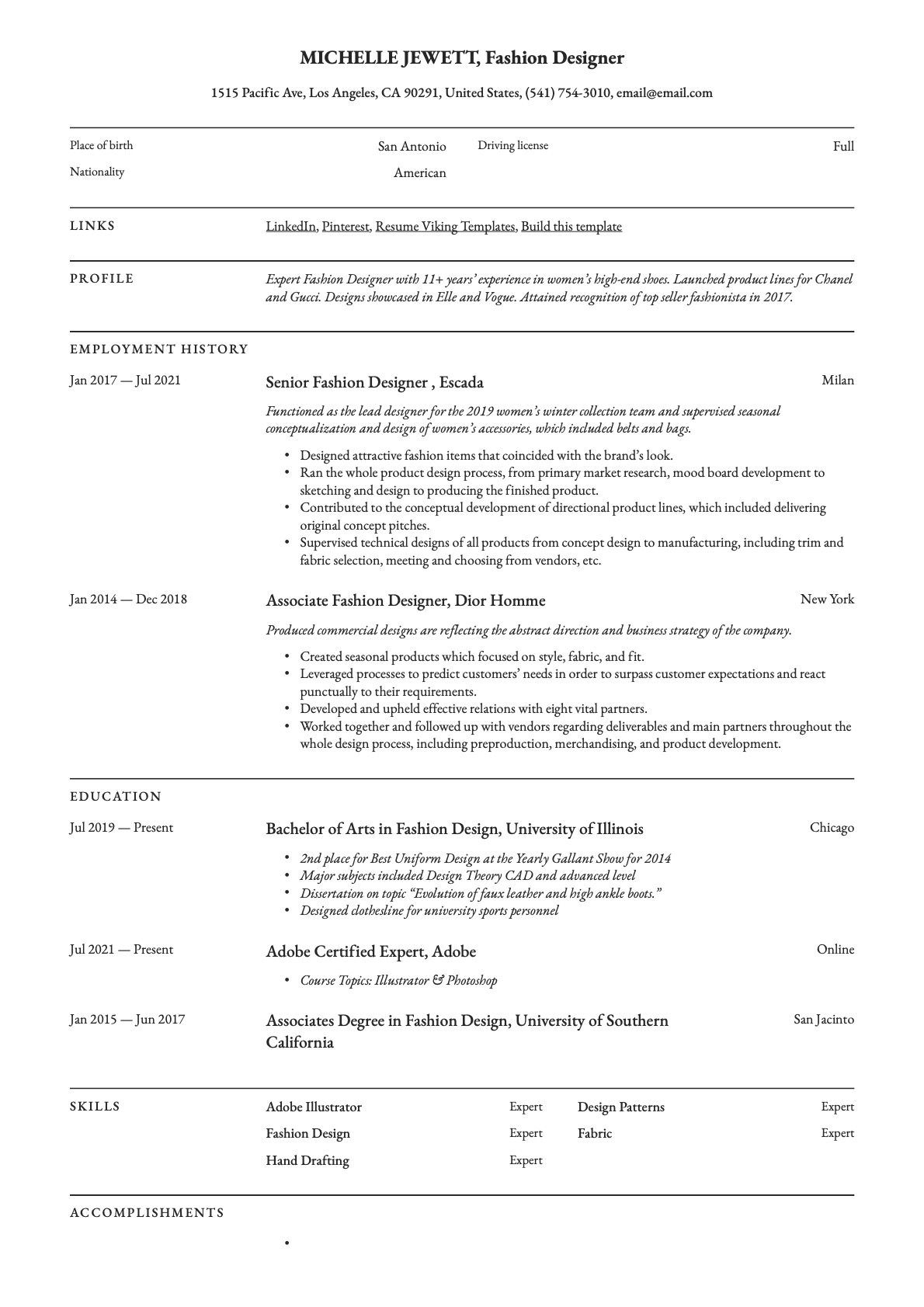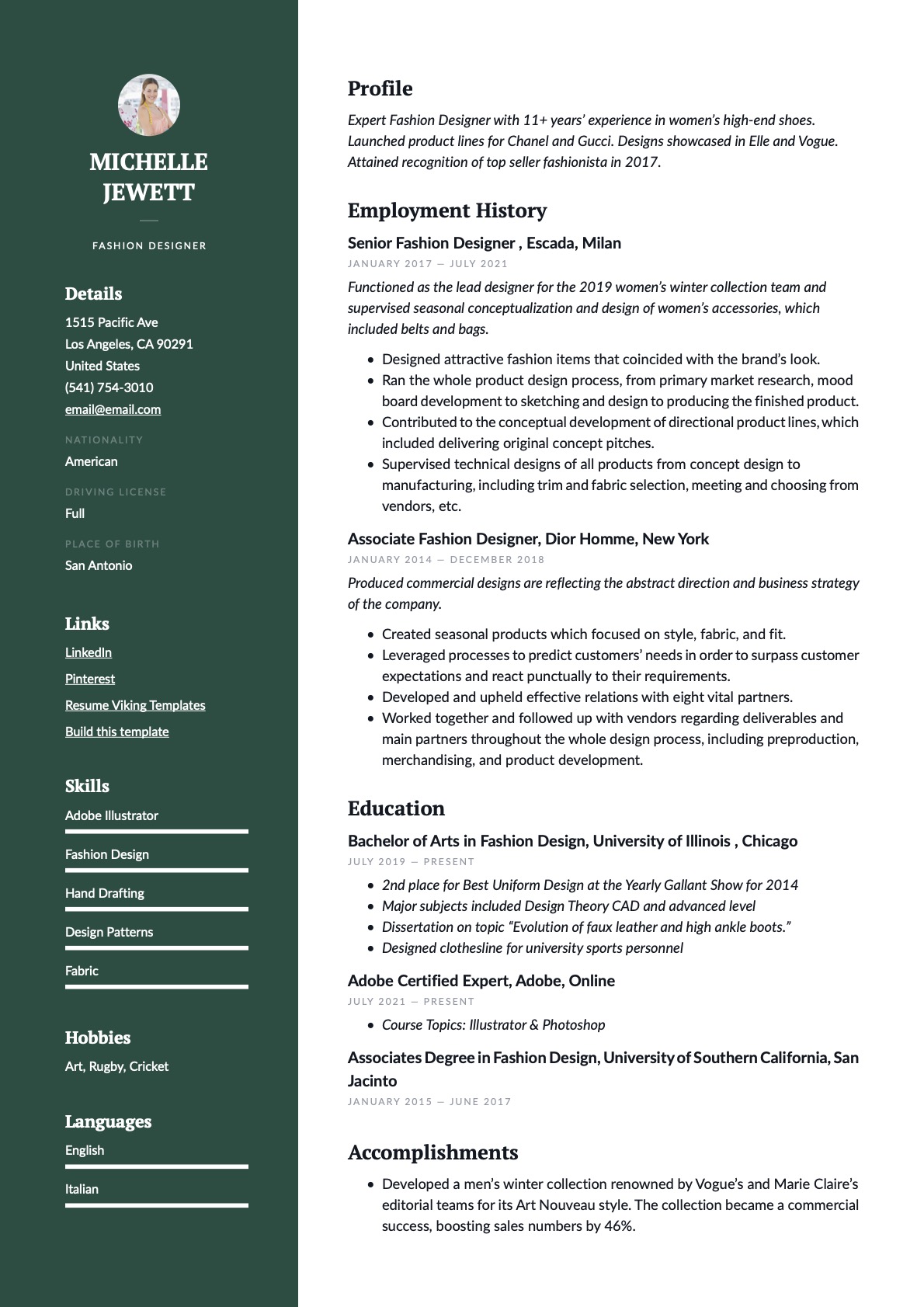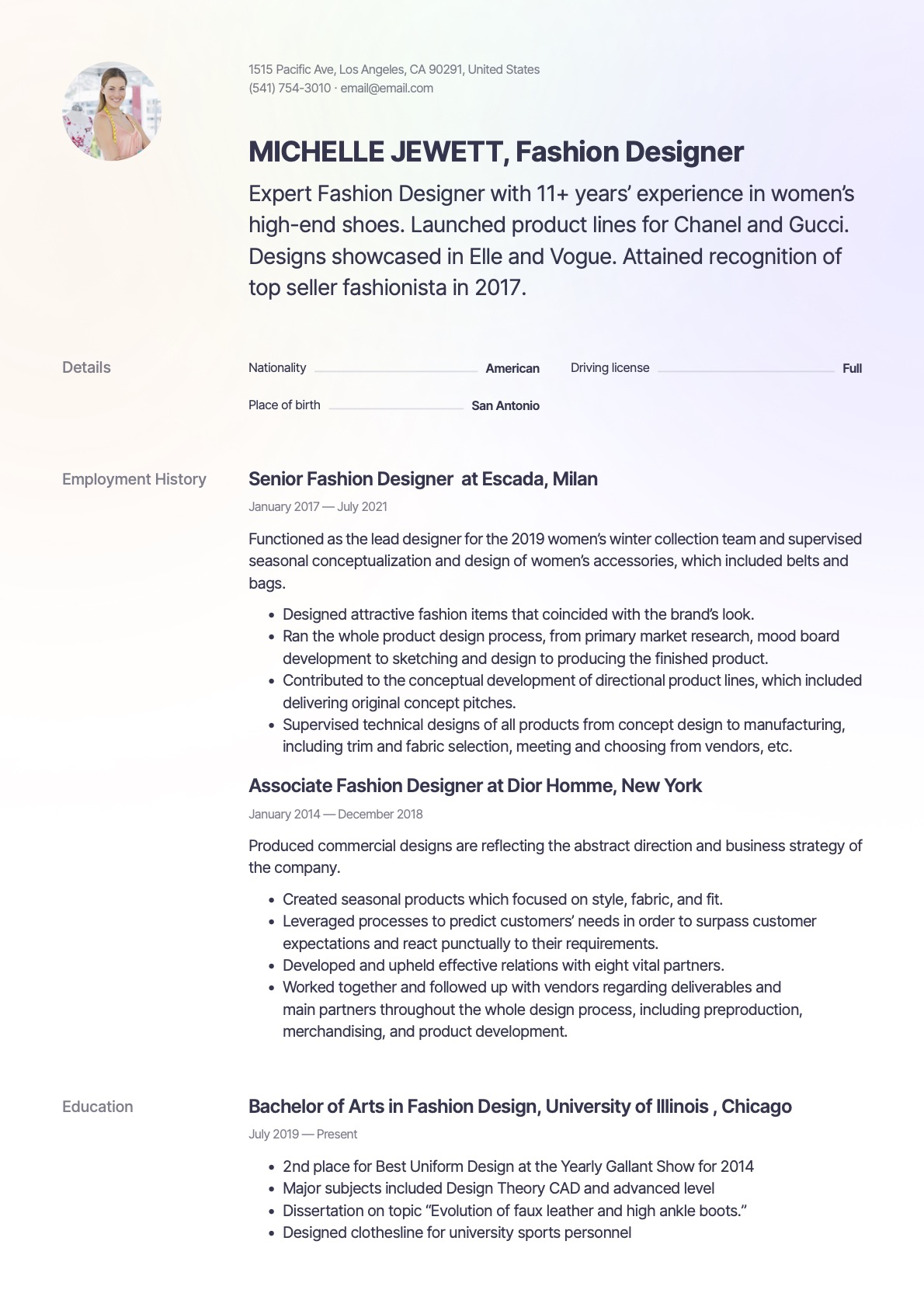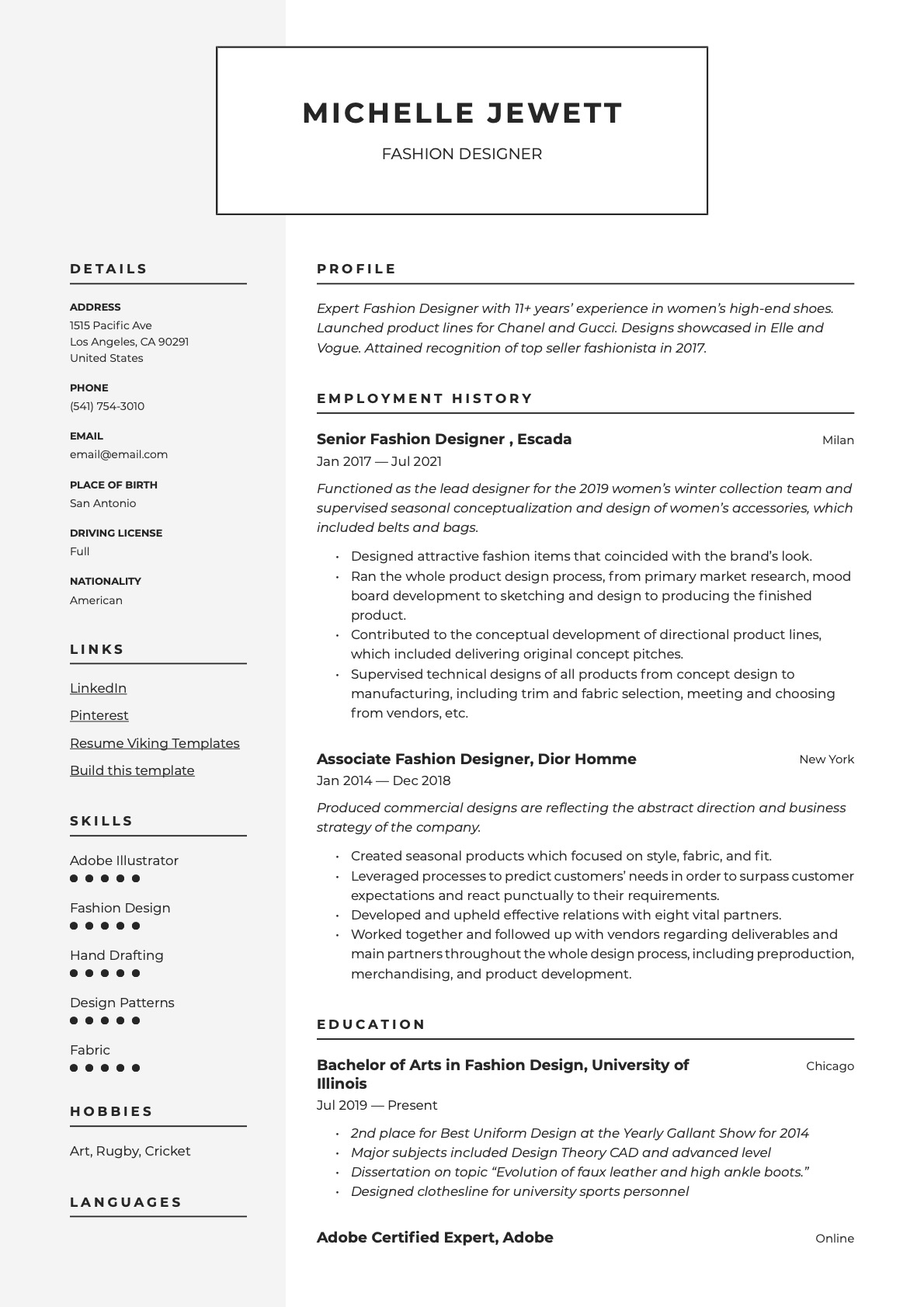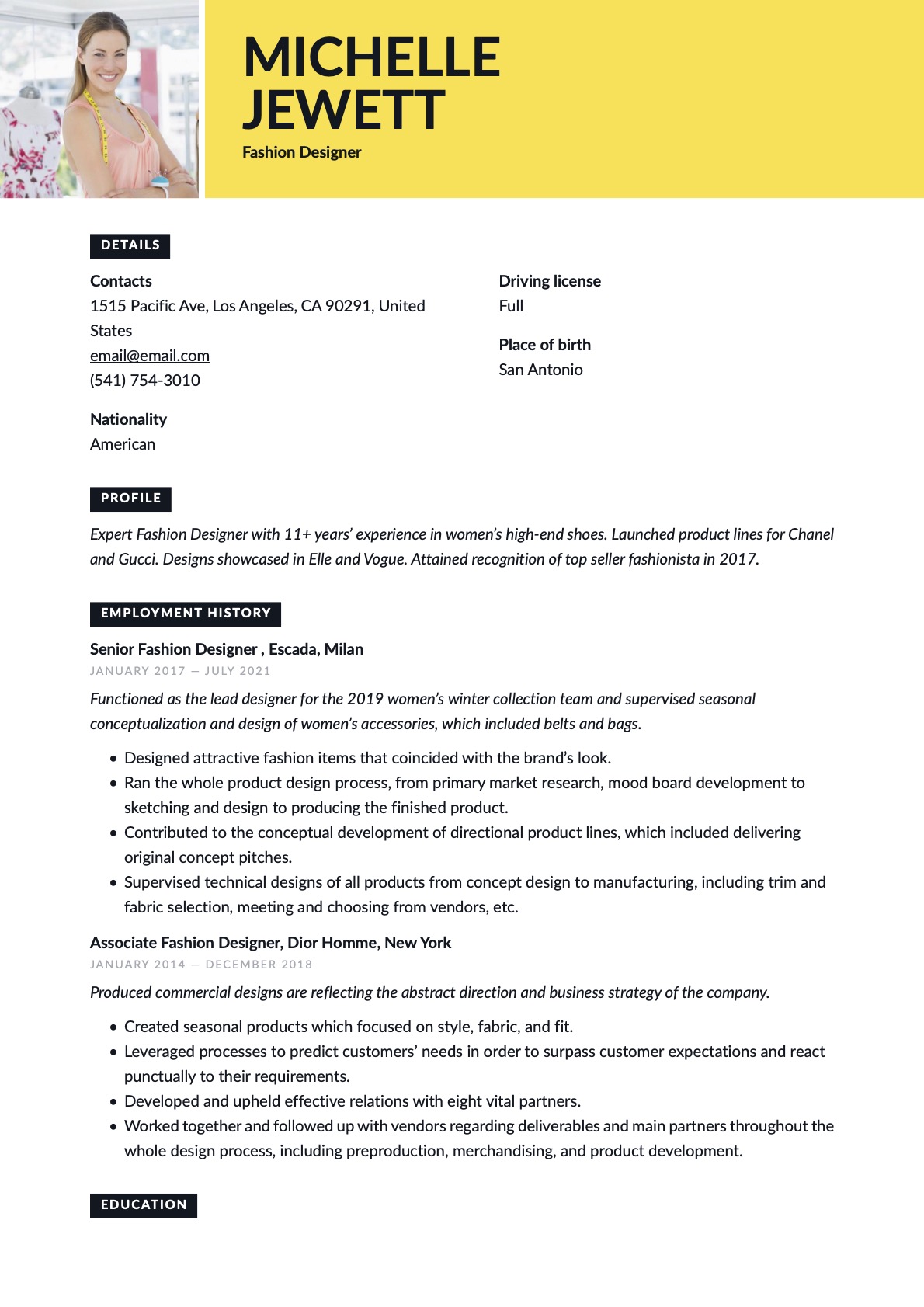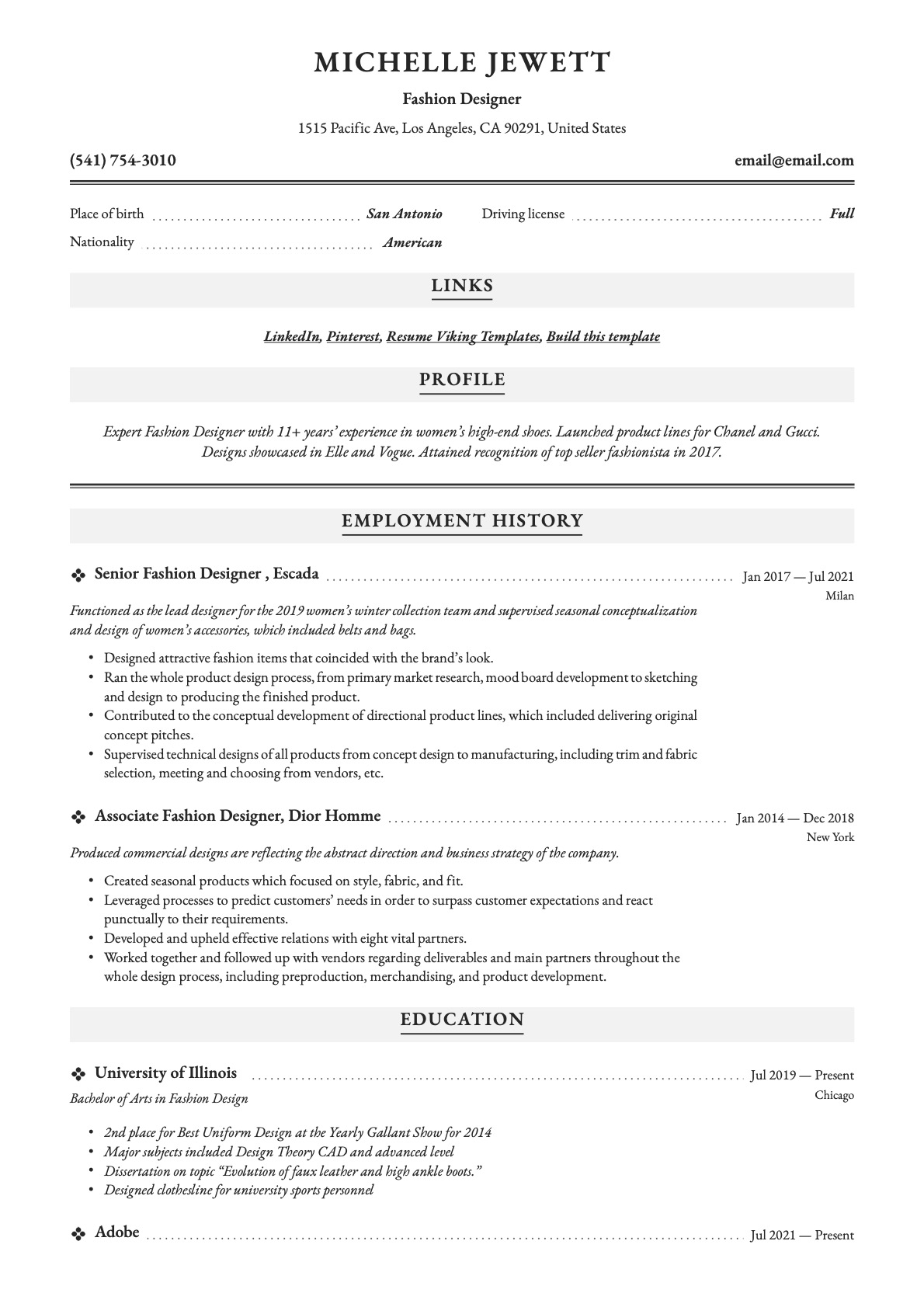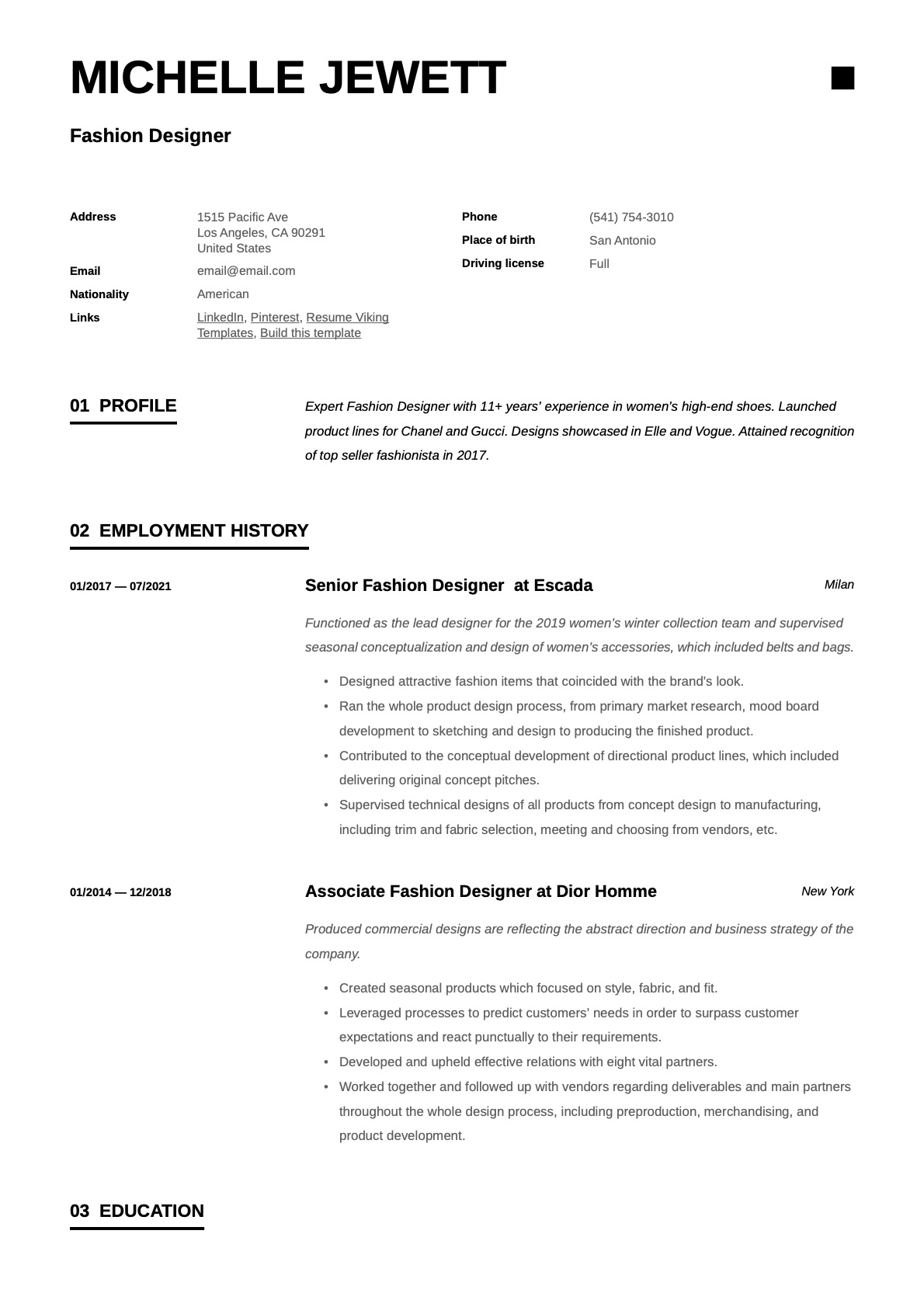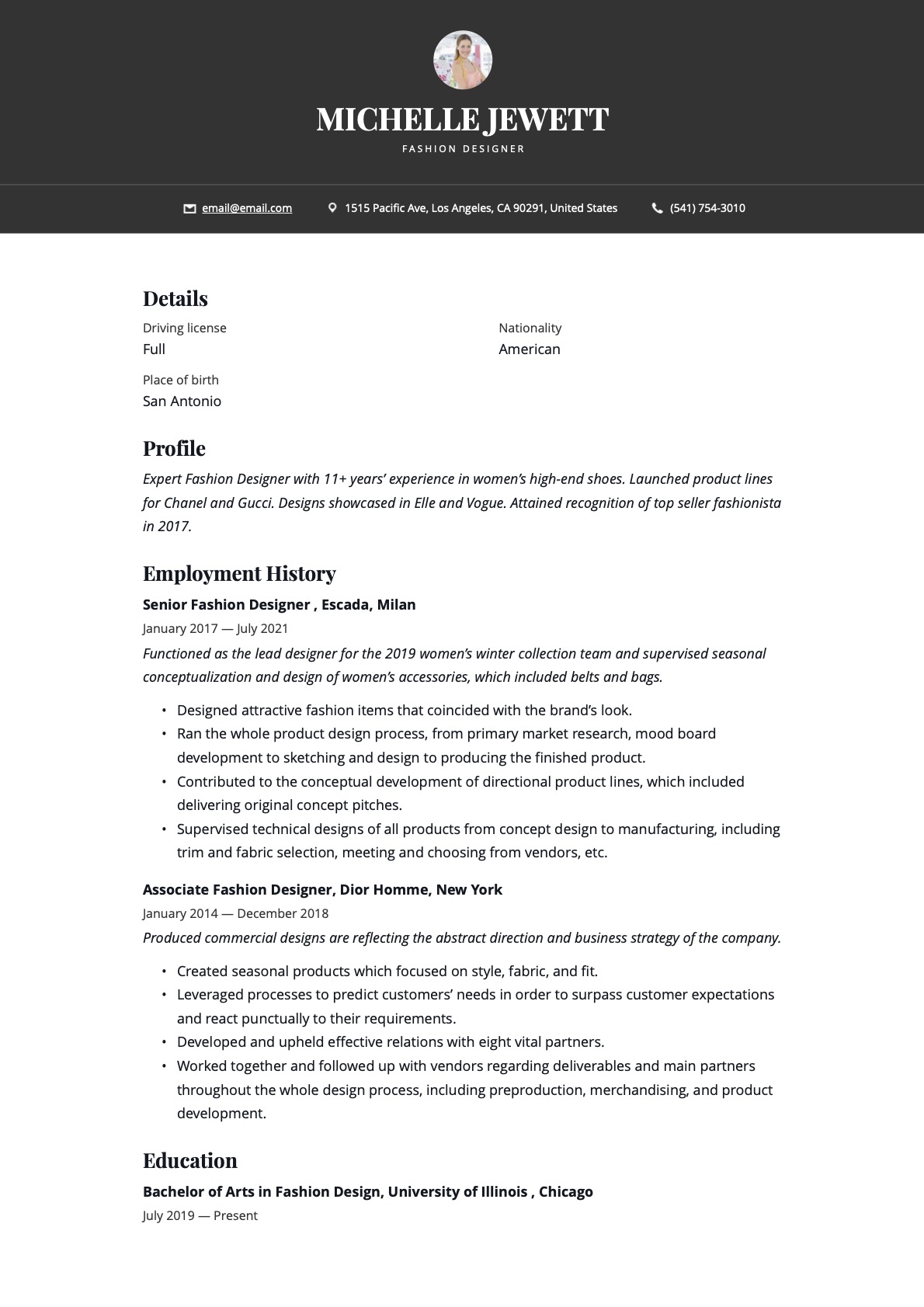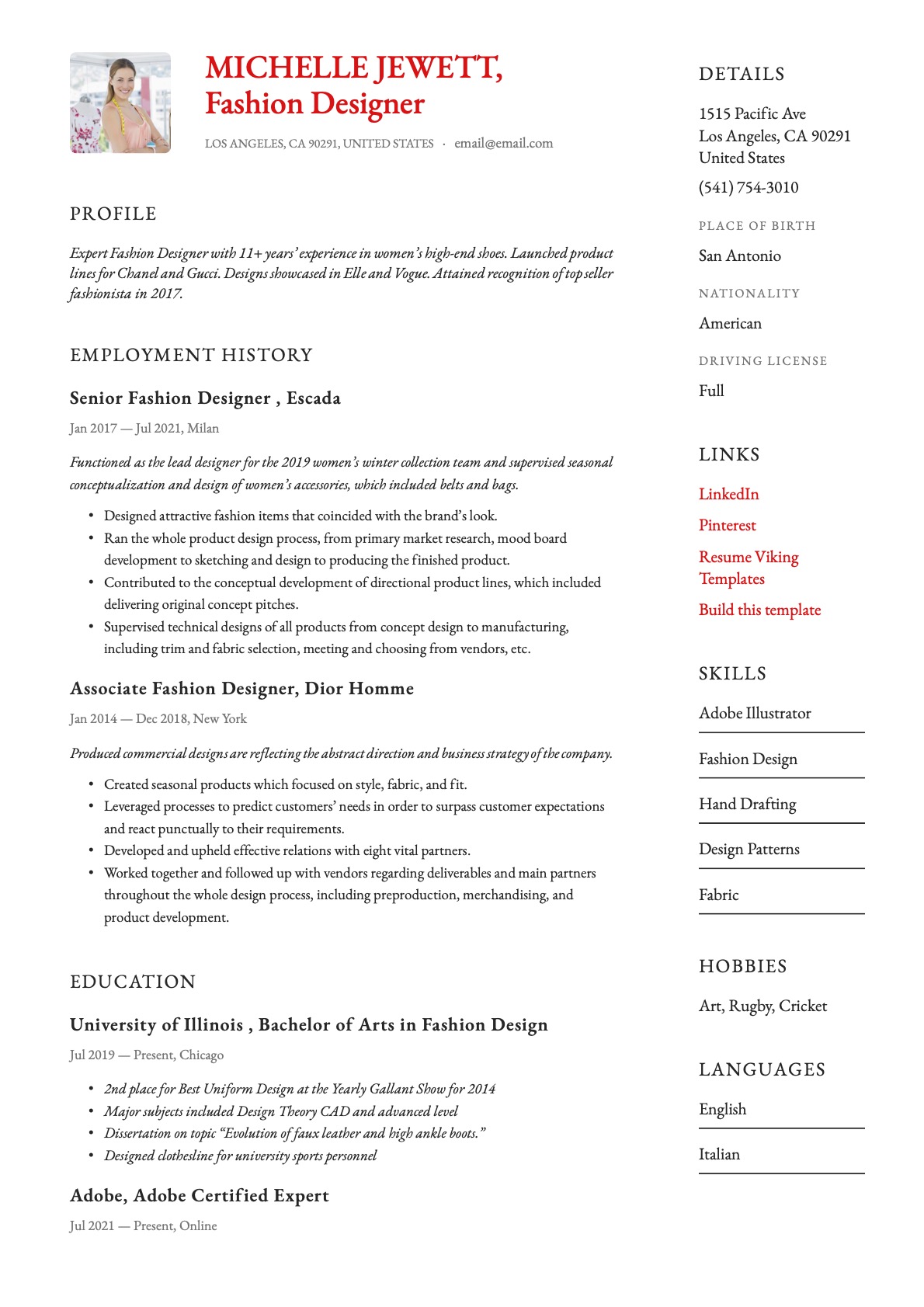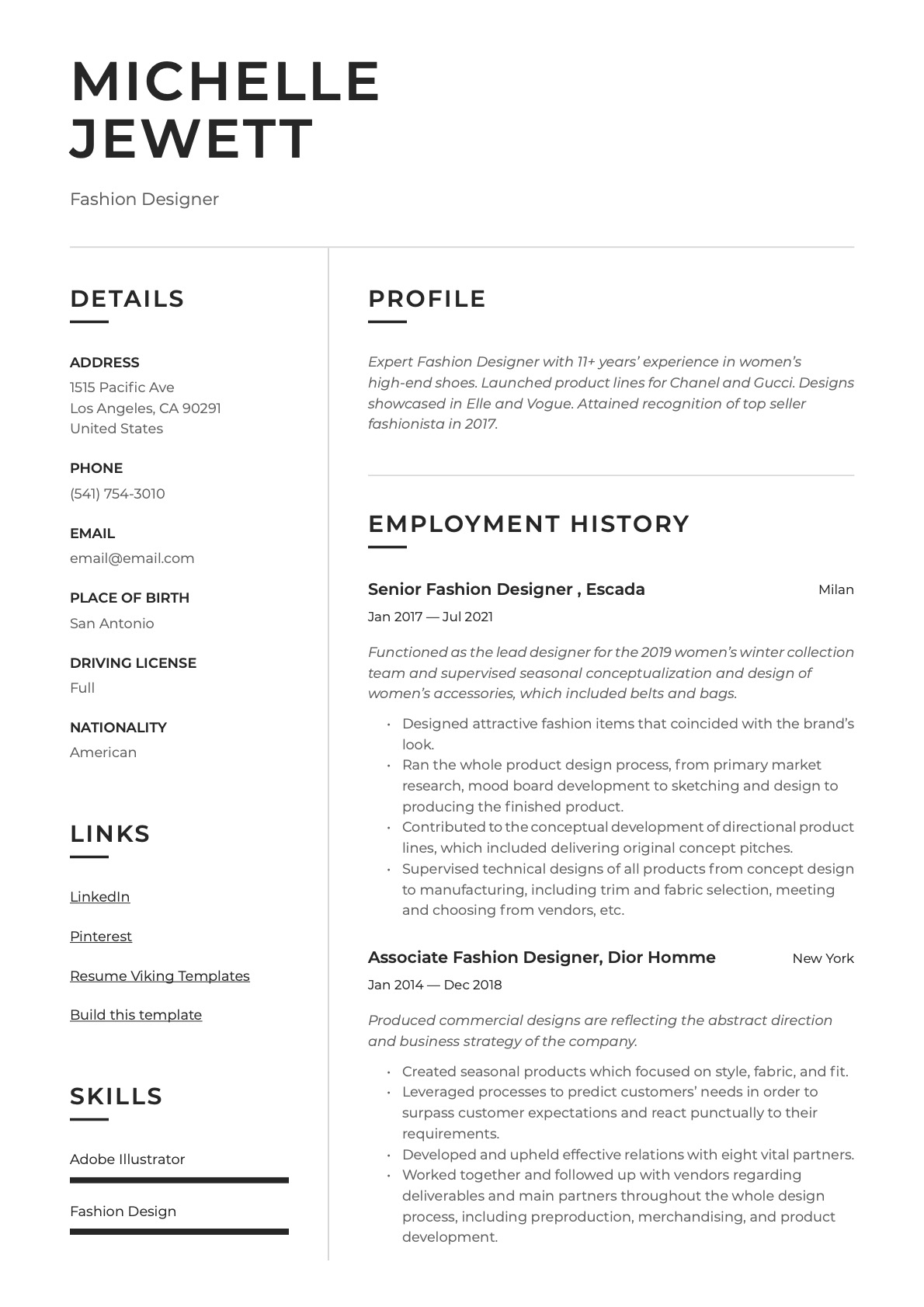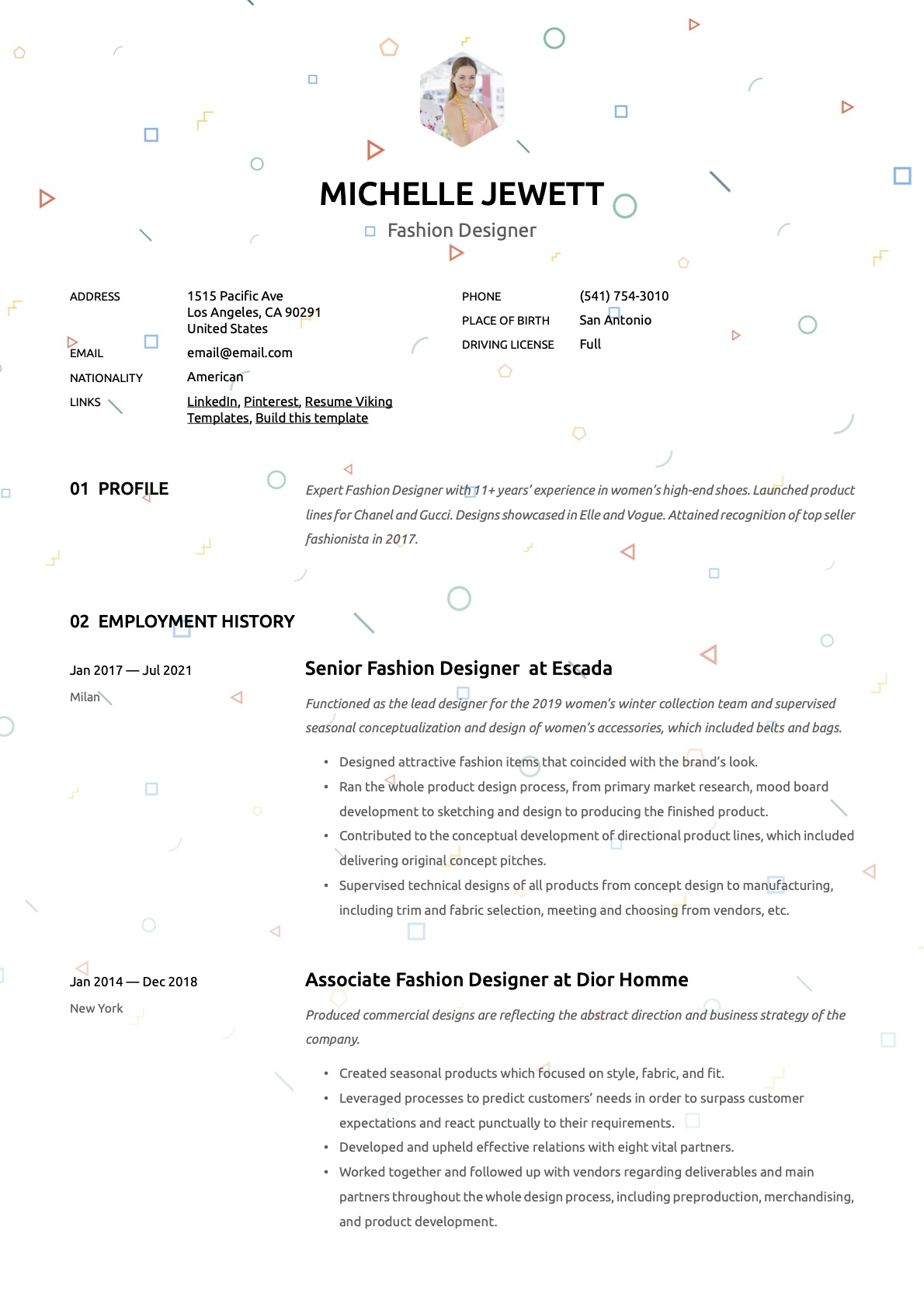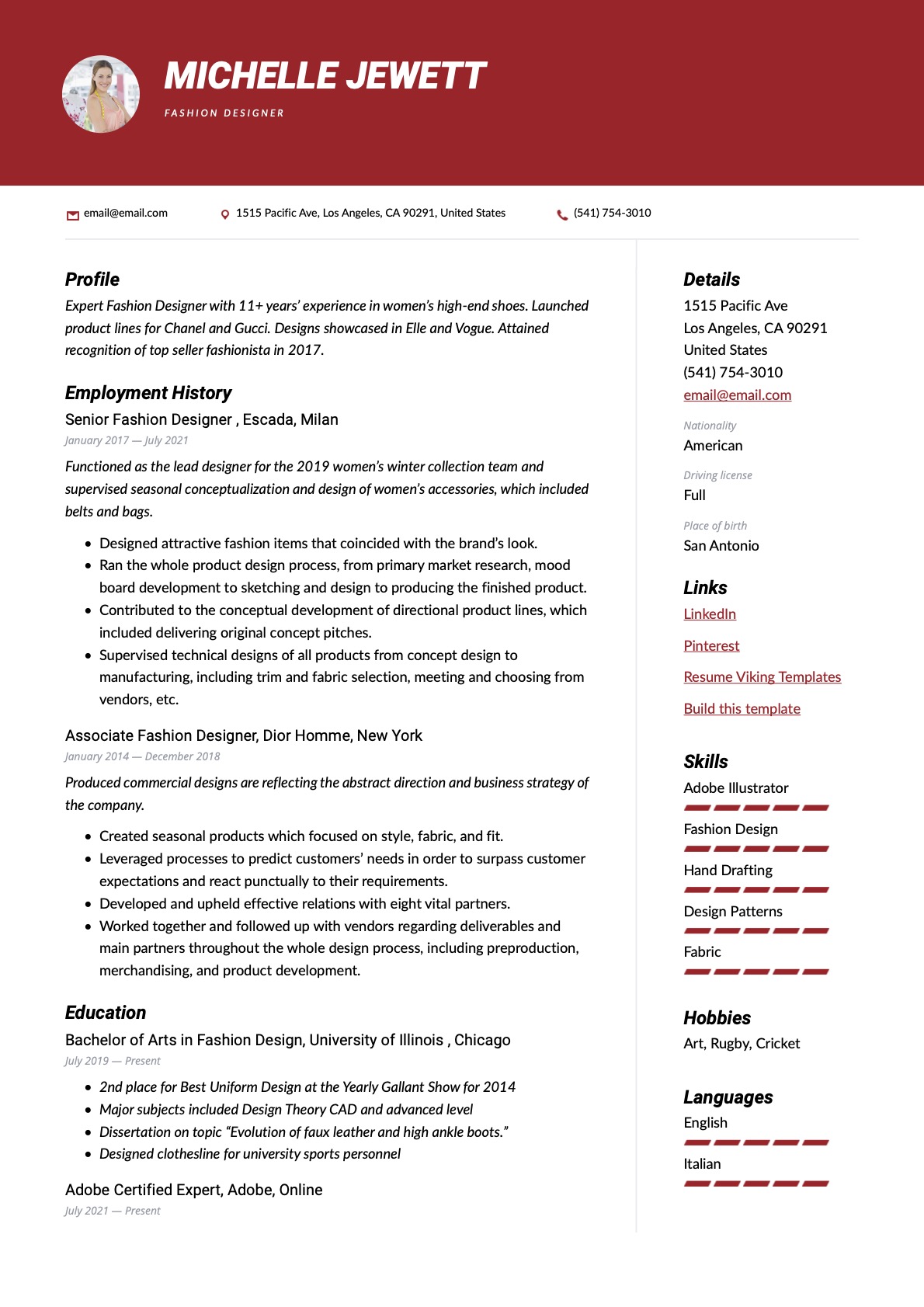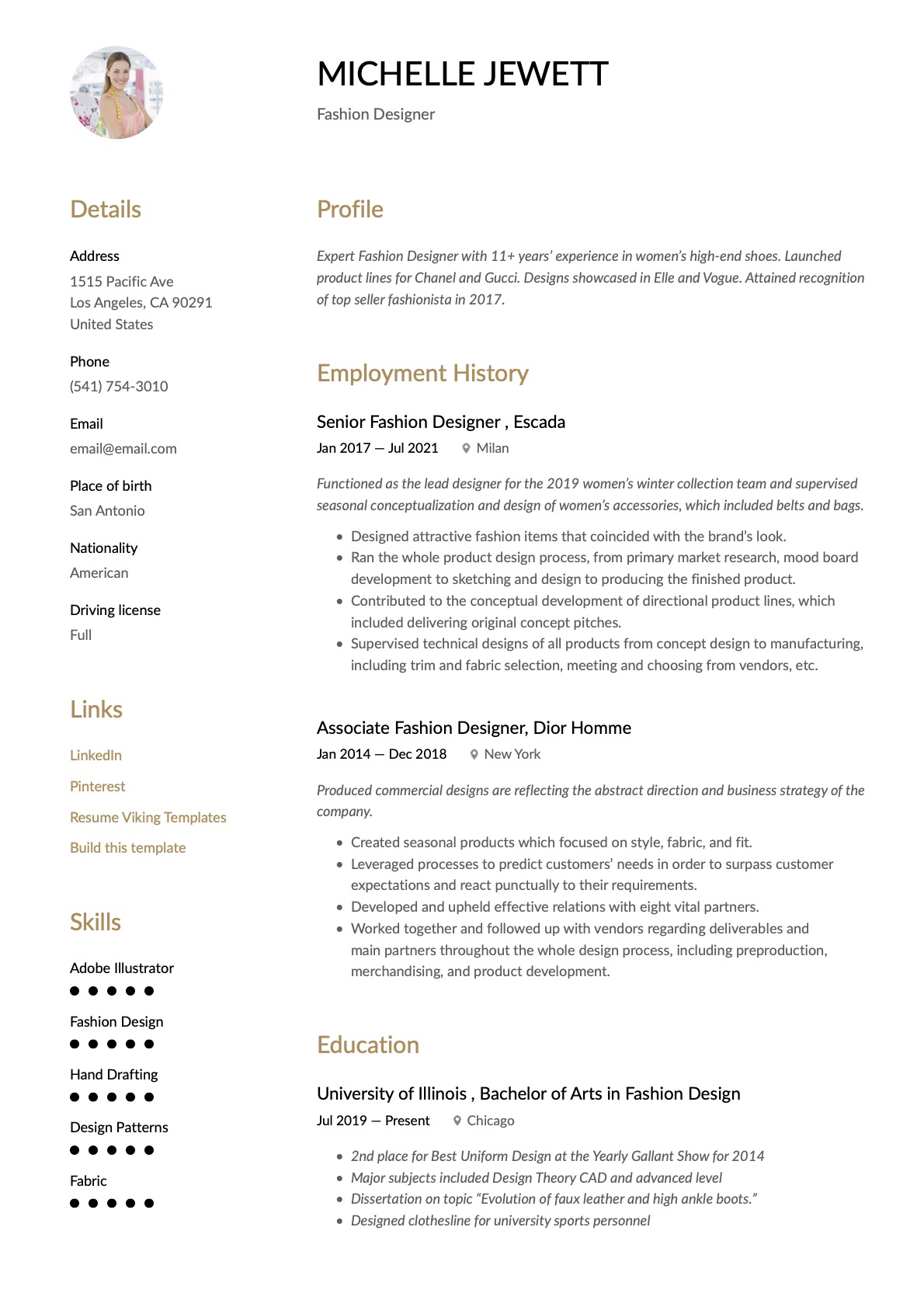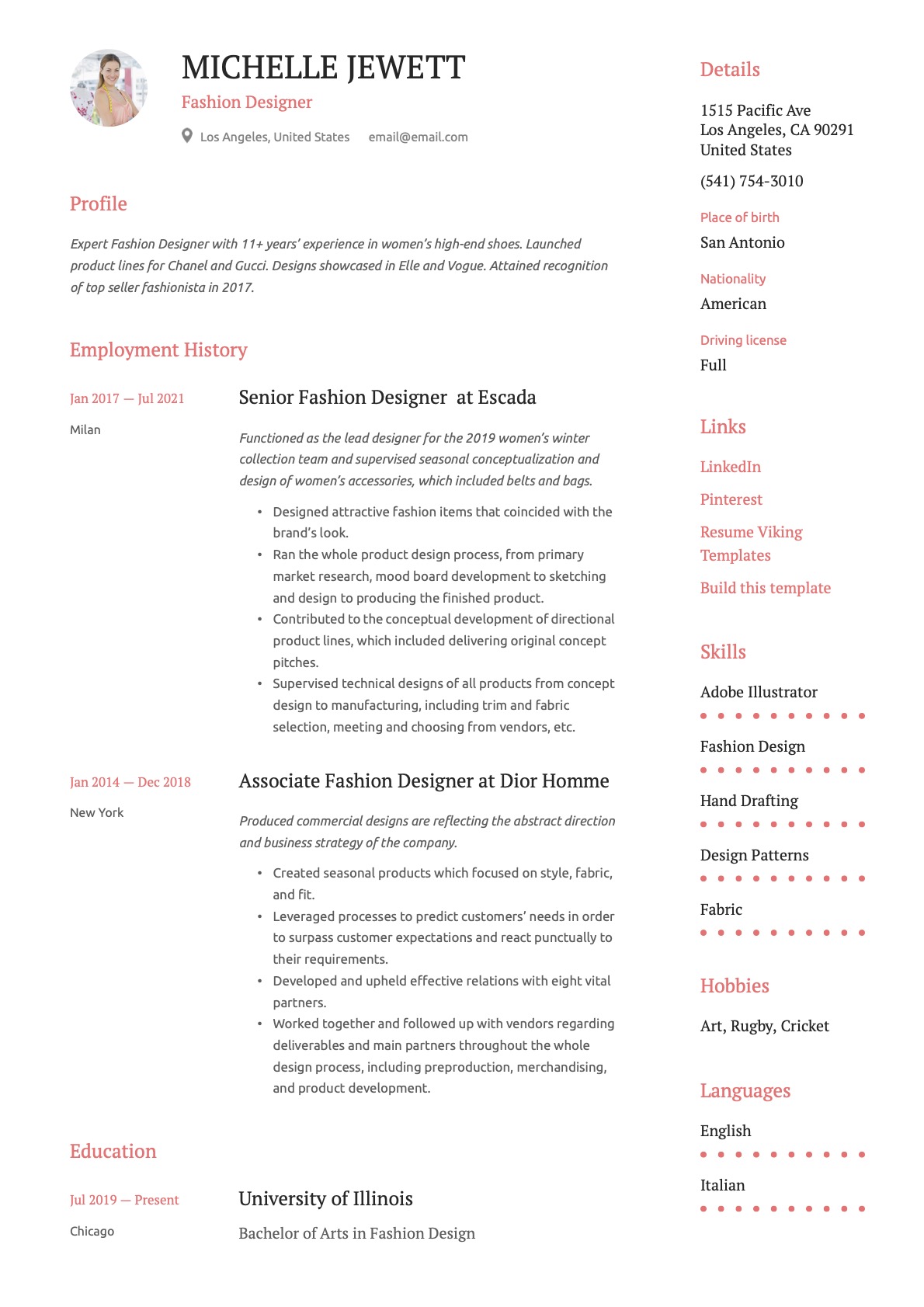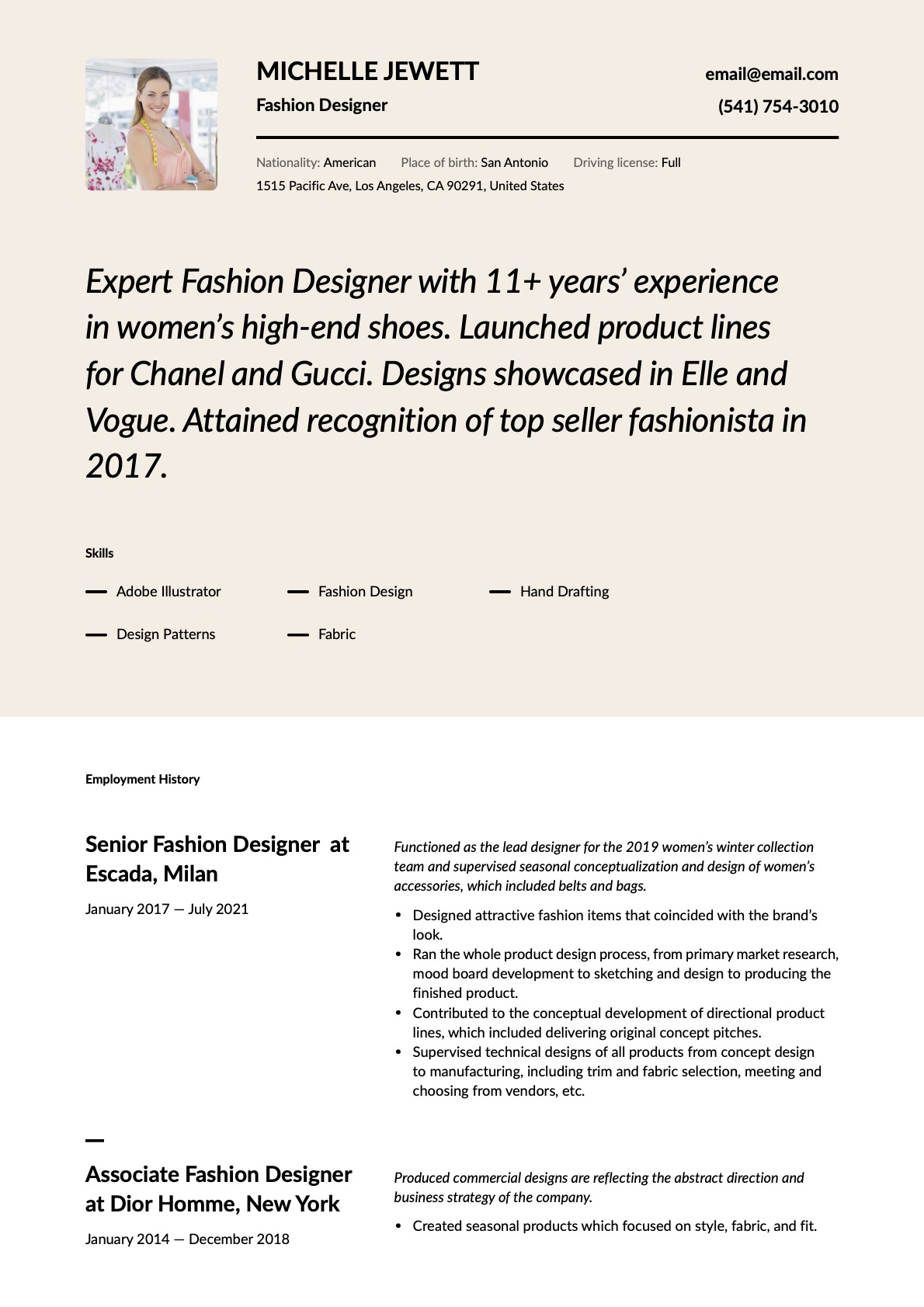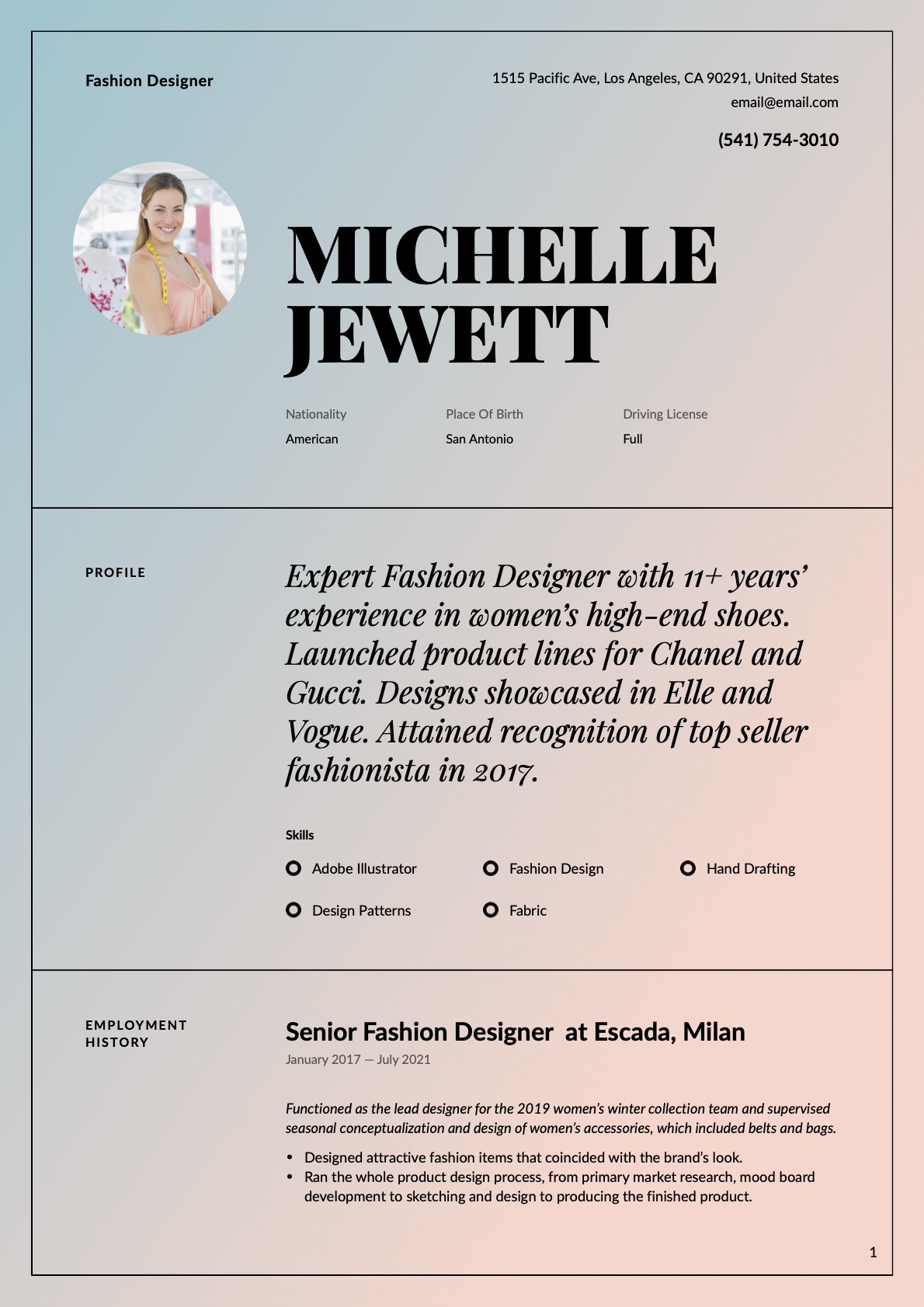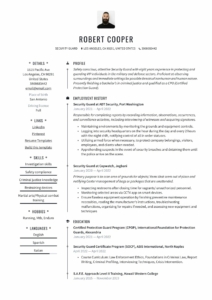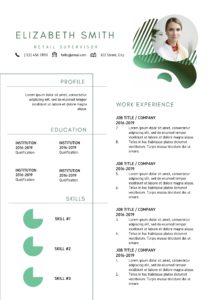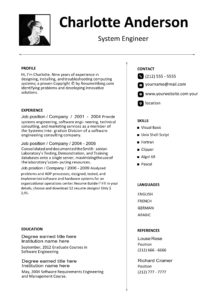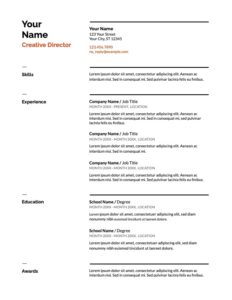Welcome to our guideline for creating a Fashion Designer resume better than 9 out of 10 out there! With our help and tips, examples, and info, we’ll have you engaging your natural creativity and keeping it professional and sharp.
We will help you to uncover your individual set of skillsets and experience to sell your true value to recruiters and, in doing so, open the door for all the interview summons coming your way!
So let’s cut to the chase (or pattern in this case), dive into the tricks of the trade to assist you in creating a fabulous Fashion Designer Resume.
What you can read in this article
Fashion Designer Resume Examples
(Free sample downloads are at the bottom of this page)
Fashion Designer Resume Writing Guide
Resume Sections
- 1. Contact information
- 2. Profile Summary
- 3. Employment History
- 4. Accomplishments
- 5. Education
- 6. Skill Section
- 7. Certification & Licensing
- 8. Extras: Languages/Awards/Publications/Volunteering/hobbies
- > Professional information
What to Highlight in a Fashion Designer Resume
It's easy to think it’s all about WHO you know instead of WHAT you know; we get it! But that’s wrong. This isn’t The Devil Wears Prada. It’s an industry with hundreds upon thousands of jobs available.
When recruiters choose who gets the interview, they don’t care about your name or your name-dropping skills. They are concerned about how valuable you were in your previous role.
- They want to see what product lines you’ve worked on. They want to know the brands you’ve worked for and the results you achieved. But first, you must highlight the kind of designer you are:
- Haute Couture Fashion Designer
- Apparel Fashion Designers
- Mass Market Fashion Designer
- Prêt-a-Porter Fashion Designer
- Fashion Accessory Designer
- Shoe Fashion Designers (Footwear Designers)
- As this industry is centered around design, your skills and style sense must come through in your resume. This isn’t an industry where your resume uses size 12 Arial font, but please, people, don’t make it look like a tacky 5th-grade project. Find that line between professional and design-oriented.
- Try always to check the job advert when deciding what to include in your resume. Usually, they list what’s important, so try to align your skills, experience, etc., with what they want and use the same words and phrases they do. Once you read a few job ads, you may notice a pattern of requirements:
- Experience working with a wide variety of fabrics
- Applicable experience in manual drawing and sketching or/and proficiency in CAD software
- Merchandising
- Extensive design theory mastery: color wheel familiarity, design conceptualization, and implementation
- Excellent sense of style
- Consumer behavior and buying habits
- Knowledge of past and current fashion trends
- It’s a wise idea to provide a link to your online portfolio in your resume. As you can’t put all your work into the resume, it’s the easiest way to include examples of your skills and heighten your chances of landing the job. You may also include your social media handles, but only if the posts apply to the job you’re trying to land. Your personal profiles don’t matter.
- Keep these questions in mind when deciding what to put in your resume:
- Why are you the best person for the job? i.e., what value will you bring to the company?
- How experienced are you with CAD software? Include a link to your portfolio for examples.
- Are you experienced in managing and implementing seasonal lines and pattern productions from idea to final product?
- Are any of your products featured in fashion shows, magazines or valued highly by consumers?
- Are you experienced in contracting and negotiating with fashion agencies, hairstylists, photographers, and shoot producers?
*Pro tip: Ensure your portfolio links are hyperlinks, but they must also come out clear if the resume is printed. The full URL must always be visible.
Contact information
- First Name and Last Name
- Physical Address
- LinkedIn Profile / Portfolio Link
Career Profile/Summary & Examples
We strongly recommend that you mold every resume you send out to the specific job description. Yeah, this is technically more work, but it’s worth it in the long run because it results in fewer applications sent out by you and more interview summons. In this case, it’s quality over quantity.
Your career summary/ objective should always start with a solid adjective or two describing the type of employee you are. You must then give your years of experience, followed by 2 or 3 of your most relevant, best skills. Include the section of the industry you received most of your experience, and end with your highest qualification.
This small paragraph at the beginning of your resume is essential as it gives the recruiter the feel of your entire resume in less than 20 seconds. They will then decide if it’s worth their time reading further into your resume, so you want this section to be banging!
Which one do you choose then? The summary or the objective? Your experience dictates that.
If you have loads of experience, choose the summary. It highlights the important stuff like your skills and experience level.
If you’re a little green or have no experience, then the objective is good because it highlights your skills and career ambitions and what you plan to bring to the table.
*Pro Tip: Write this section last. It’s easier to summarize this section once you have all the info laid out in front of you.
Examples:
Fashion Designer Summary 1
“Expert Fashion Designer with 11+ years’ experience in women’s high-end shoes. Launched product lines for Chanel and Gucci. Designs showcased in Elle and Vogue. Attained recognition of top seller fashionista in 2017.“
Fashion Designer Summary 2
“A gifted and customer-oriented designer with 5+ years’ experience in luxury brand settings. Has a professional eye for detail and commercial fashion product- styling. Excited to join Givenchy and bring a creative tone and inspiring new concepts. In previous jobs, developed a highly praised men’s winter collection that increased sales by 38% relative to the previous year.”
Fashion Designer Summary 3
“Top-performing fashion designer with 9+ years’ experience in developing and visualizing fashion concepts. Highly proficient in generating hand designs to develop impressions. Recognized for planning and developing fashion ranges following clients’ wishes.“
Fashion Designer Summary 4
“Inventive Fashion Designer with 7+ years’ solid track record in staying relevant with emerging fashions. Recognized for crafting fresh and aesthetically pleasing designs meeting customers’ desires. Looking for a position at Company X.“
Employment History
Your experience dictates your resume layout. Entry-level designers must begin with their education sections first, as this will be more impressive than their work experience. Your skills will follow this. If you’ve been around the block a few times, showcase your experience first. Your professional experience will be what recruiters are looking for, before they check your education.
This section should be laid out in reverse-chronological order. Your most recent job first, then work your way backwards. Ensure you have the job title, years you worked there, and a bullet point list of your responsibilities. Please don't hesitate to quantify these as well.
Begin every sentence with a solid power verb. You could say “created ready-to-sell goods for a boutique on eBay” and come across as unimpressive, dare we say, generic.
Or you could say “conceptualized from beginning to end a modern clothing line for a women’s boutique on Amazon, that powered $600K in monthly sales”.
You should pretty much do that for all your points, and this section needs to be very specific. You must also include the number of product lines you worked with which design process you worked on.
Utilize the industry’s jargon in this section, and it adds that extra zing you need to impress the recruiters. If you still struggle to picture this format, follow these steps:
- What did you do?
- Why did you do it?
- What did it result in?
Senior Fashion Designer Escada, New York City, NY
(January 2017- January 2019)
Functioned as the lead designer for the 2019 women’s winter collection team.
Supervised seasonal conceptualization and design of women’s accessories, which included belts and bags.
- Designed attractive fashion items that coincided with the brand’s look.
- Ran the whole product design process, from primary market research, mood board development to sketching and design to producing the finished product.
- Contributed to the conceptual development of directional product lines, which included delivering original concept pitches.
- Supervised technical designs of all products from concept design to manufacturing, including trim and fabric selection, meeting and choosing from vendors, etc.
Associate Fashion Designer Dior Homme, New York, NY
(January 2015- December 2019)
Produced commercial designs are reflecting the abstract direction and business strategy of the company.
- Created seasonal products which focused on style, fabric, and fit.
- Leveraged processes to predict customers’ needs in order to surpass customer expectations and react punctually to their requirements.
- Developed and upheld effective relations with eight vital partners.
- Worked together and followed up with vendors regarding deliverables and main partners throughout the whole design process, including preproduction, merchandising, and product development.
Job Description Examples
This section may be the one thing that pushes your resume into the “yes” or “no” pile. However creative you’ve been in the rest of your resume, be straightforward and concise in this section. Keep it professional. Below we have given you a list of duties to choose from and mold to your specific job requirements:
A Fashion Designer’s role may entail:
- Championing concepts to various groups of category owners, developers, and executives in informal and formal presentations.
- Fluent in Mandarin with evidence of presenting to and influencing senior management.
- Working attentively with members of the design team, creating a consistent design system across features, projects, and core UI/UX and tools.
- Developing and building relationships between teams and disciplines aimed at promoting collaboration and efficiency.
- Envisioning cross-platform systems of design and patterns in association with several stakeholders.
- Mentoring and coaching other designers, raising the bar for UX design, and helping individuals broaden their professional growth.
- Managing, developing, and educating direct reports. Providing guidance, mentoring/coaching, and feedback concerning direct reports performance.
- Attending all first fits in collaboration with Technical Design for aesthetic comments/input and styling.
- Preparing and presenting seasonal product reviews to merchant teams and senior management.
- Partnering with Trend, creating line presentation boards for utilization at Concept and Development Review.
- Working cross-functionally with the Development and Color and Fabric teams to manage collections for presentation through artwork print, silhouettes, fabric, presentation boards, and outfit coordination.
- Coordinating visual boards and samples for driving modernity to the Brand.
- Preparing artworks and all information associated with the artworks for Product Development hand-off.
- Leading or co-leading in the development and design of all products.
- Creating and developing presentation boards and color schemes.
- Managing typical design room and admin tasks.
- Extensively researching artistic ideas and providing input for designs into applicable collections.
- Working well with all design and tools techniques involved in producing garments, blueprints, precision technical plans, drawings, and models.
Accomplishments
Fashion designers know all about “proof of concept.” This section is basically your proof of concept. It is NOT, however, another list of the duties you’ve performed. Recruiters know what you should be doing in your role, but what you must demonstrate are the positive results of you doing your work so well. What achievements have you made happen that make you super proud of yourself?
Quantification 101
Now that you have a list written down of your achievements, take some time to quantify them. It is essential that you back up your accomplishments with number values. This not only gives your accomplishments legitimacy, but it also provides the recruiters with something objective to measure your proficiency levels with.
Let’s look at some quantified examples of resume accomplishments or career highlights for Fashion Designers:
- Developed a men’s winter collection renowned by Vogue’s and Marie Claire’s editorial teams for its Art Nouveau style. The collection became a commercial success, boosting sales numbers by 46%.
- Created a highly admired women’s summer collection that increased revenue by 38% compared to last year.
- Managed a team of 6 designers to create 155 SKUs each month for a children’s apparel company.
- Enhanced the company’s main designing platform from 6 to 4, resulting in costs-savings of $67,000 per SKU due to scale efficiencies.
Let’s look at the same accomplishments, but without quantification
- Developed a men’s winter collection renowned by Vogue’s and Marie Claire’s editorial teams for its Art Nouveau style. The collection became a commercial success, boosting sales numbers.
- Created a highly admired women’s summer collection that increased revenue compared to last year.
- Managed a team of designers to create SKUs for a children’s apparel company.
- Enhanced the company’s main designing platform resulting in costs-savings due to scale efficiencies.
Pretty boring, hey?
Education
This section is crucial as most (potentially all) companies need at least a bachelor’s for you to apply. It’s even a good idea to include your qualifications if they aren’t related to design. Recruiters will want to see that you have something behind your name.
Those fashion designers who are less experienced or are fresh out of college may include their relevant school projects and coursework. If you have more than five years of working experience, only include your post-school qualifications. It’s critical to show the recruiters your degrees. It proves to them that you have the necessary theoretical foundation to do the job and that you are keen to continue learning and developing your skills.
Your education section should be laid out like this:
- Years you studied.
- Full degree name.
- Full name of the institute.
- Institute location.
- If you just graduated, include your GPA if it’s higher than 3.6.
Examples:
2012- 2014 Bachelor of Arts in Fashion Design, the University of Illinois at Chicago, Chicago, IL.
- 2nd place for Best Uniform Design at the Yearly Gallant Show for 2014
- Major subjects included Design Theory CAD and advanced level
- Dissertation on topic “Evolution of faux leather and high ankle boots.”
- Designed clothesline for university sports personnel
2016- Adobe Certified Expert, Adobe, Online
- Course Topics: Illustrator & Photoshop
2019- 2021 Associates Degree in Fashion Design, University of Southern California, Los Angeles, CA.
Skills
Try and align the skills you include to the skills they want in the job advert. The closer your skills resemble the ones they want, the higher the chances of them choosing you. Make a list of all your skills, then read through the job advert. Cross-reference them and choose the best, most relevant ones to include in the resume.
Avoid using bullet point lists in this section.
A skills matrix like the ones shown below is a better, more professional way to display your skills. Because you’ll be working with people a lot, recruiters will be very interested in your soft skills, not just your hard/ technical skills. Please include them in their own separate matrix. A nice touch would be to add your experience level next to each listed skill:
Technical Skills Matrix
| Core Skill | Experience Level (1-Expert, 2-Skilled, 3-Novice) |
|---|---|
| Sketching | 1 |
| Adobe Suite | 2 |
| Pattern making | 1 |
| Sewing | 1 |
| Clothing technology | 1 |
| Textile engineering | 1 |
| Cutting | 1 |
| Processing | 2 |
| Fitting | 2 |
| Fashion trends | 1 |
Soft Skills Matrix
| Artistic | Team Player |
| Creative | Enthusiastic |
| Detail Orientated | Deadline Driven |
| Collaborative | Determined |
| Diplomatic | Compromising |
| Tenacious | Focused |
| Passionate | Visionary |
| Strong Communicator | Accountable |
Don’t have all the technical skills required for the job—but still believe you may be a great fit – soft skills such as the ones listed above, may just get you into the interview pile.
Qualifications/Certifications associated with Fashion Designers
| Adobe Certified Expert - Adobe Illustrator CC | Adobe Certified Expert - Adobe InDesign CC | American Academy of Fashion Design Certification |
| Free Fashion Courses & Classes Online (Skillshare) | Fashion Courses Online (Udemy) | Fashion Management: Create your Own Sustainable Brand by Institute |
| Francais de la Mode (Future Learn) | Anna Wintour Teaches Creativity and Leadership (MasterClass) | Fashion As Design By The Museum of Modern Art (Coursera) |
| Fashion Design and Creation by Hong Kong Polytechnic (edX) |
Optional Extras for Fashion Designer Resumes
You now have all the right sections for your resume, but so does everyone else. Use extras sections to help make you stand out from the rest. Show them who you are as a human being.
You can include:
- Personal interests
- Professional achievements
- Volunteer experience
- Languages
Professional Information on Fashion Designers
Sectors: Fashion, Textile, Apparel, Marketing, Design,
Career Type: Design, Production, Art, Styling,
Person type: Designer, Creator, Visualizer, Maker, Producer Developer
Education levels: From Post School Qualifications and upwards
Salary indication: $ 68 959 per annum (CareerExplorer)
Labor market: Decline of 4% between 2019 – 2029 (BLS)
Organizations: Various
Download Fashion Designer Templates in PDF
